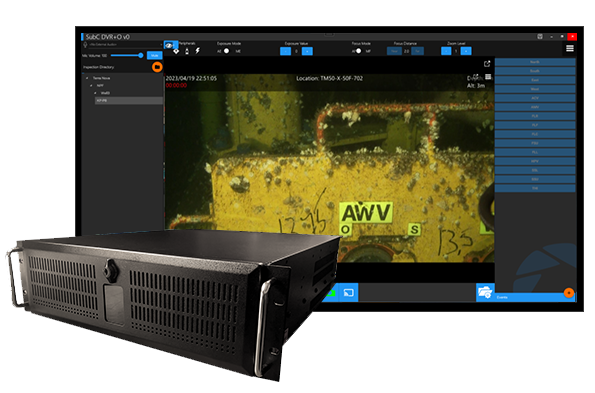Virtual Machine Compatibility for DVRs in Offshore Operations
Efficiency, adaptability, and technological innovation are pivotal factors in the success of offshore operations. A groundbreaking technology that has recently come to the forefront is virtual machine compatibility for digital video recorder (DVR) systems, with SubC Imaging leading the way as one of the few companies offering this feature. In this article, we will explore the significance of virtual machine compatibility for DVR systems in offshore energy applications, examining its advantages and impact on enhancing efficiency and productivity in these demanding environments.
What is a Virtual Machine?
A virtual machine (VM) is a software-based emulation of a physical computer or server. It allows multiple operating systems (OS) to run concurrently on a single physical machine, known as the host system. Each virtual machine, or guest system, operates independently of the others, with its own virtualized hardware resources, including CPU, memory, storage, and network interfaces.
What are the Advantages of Virtual Machines?
One of the key advantages of virtual machines is their ability to provide isolation and encapsulation of operating environments. This means that each VM operates independently of others, with its own dedicated resources and configurations, preventing interference and conflicts between different OS instances.
Additionally, VMs offer flexibility and scalability, allowing organizations to quickly deploy and scale up or down their computing resources as needed. This agility makes VMs well-suited for a wide range of applications, including offshore energy operations.
What is a DVR for Offshore Applications?
DVR systems, also referred to as Digital Video Recorders, are specialized tools engineered to capture and preserve high-quality video footage from underwater environments. These systems adapt to various configurations, offering both software-only and software-and-hardware combinations. With software-only options, users can install high-performance software on their existing hardware or PCs, while the combined software and hardware configurations provide additional reliability and performance enhancements. Regardless of the configuration chosen, subsea DVR systems are essential components in industries such as offshore energy, marine research, and environmental monitoring, enabling efficient storage and review of underwater video content.
Why is Virtual Machine Compatibility Important for DVRs in Offshore Operations?
Optimizing Resource Utilization
Offshore energy operations are often characterized by remote locations, limited physical space, and stringent environmental conditions. In such environments, optimizing resource utilization is paramount. Virtual machine compatibility allows DVR systems to consolidate multiple functions onto a single hardware platform, reducing the need for additional equipment and minimizing physical footprint onboard offshore installations. By leveraging virtualization technology, offshore energy companies can streamline their operations, minimize hardware costs, and enhance overall resource efficiency.
Flexibility and Scalability
The dynamic nature of offshore energy operations demands flexible and scalable solutions that can adapt to changing requirements and evolving technologies. Virtual machine compatibility provides DVR systems with the agility to scale up or down based on demand, without the need for costly hardware upgrades or replacements. This flexibility enables offshore energy companies to respond quickly to changing market conditions, operational demands, and technological advancements, ensuring that their DVR systems remain relevant and effective in the long term.
Streamlining Data Management
Data management is a critical aspect of offshore energy operations, with vast amounts of data generated from various sources, including sensors, cameras, and other monitoring devices. Virtual machine compatibility enhances DVR systems' ability to collect, store, and analyze this data by seamlessly integrating with existing data management infrastructure, such as cloud-based platforms and centralized servers. By centralizing data storage and analysis, offshore energy companies can gain valuable insights into their operations, identify trends, and make informed decisions in real time, leading to improved efficiency and productivity.
Enhancing Collaboration and Remote Operations
Collaboration between onshore and offshore teams is essential for the success of offshore energy operations. Virtual machine compatibility enables DVR systems to support remote access and operations, allowing offsite personnel to monitor, analyze, and act upon real-time data streams from offshore installations. This capability facilitates seamless collaboration, accelerates decision-making, and improves overall operational efficiency. Additionally, if a DVR can facilitate multiple channels, it allows for simultaneous recording and analysis of data from multiple sources, further enhancing collaboration and enabling more informed decision-making.
Future-Proofing Offshore Operations
Virtual machine compatibility future-proofs DVR systems by ensuring compatibility with emerging technologies and standards. This forward-looking approach enables offshore energy companies to stay ahead of the curve and leverage new opportunities for innovation and efficiency. Again, if the DVR has multi-channel capability, it ensures that it can adapt to future requirements by accommodating the recording and analysis of data from a diverse range of sources, including new sensor technologies, imaging devices, and monitoring systems.
SubC’s DVR + Overlay - A Step Above the Rest
Beyond its compatibility with virtual machines, SubC’s DVR+ Overlay system stands out as a pivotal technology in offshore energy operations. It offers unmatched capabilities for capturing, analyzing, and visualizing crucial data from underwater environments. Able to integrate seamlessly with Woods' Nexus and Aize's Coabis and Integrity Elements, this system provides a comprehensive view of offshore installations, marine habitats, and environmental conditions. With its groundbreaking multi-channel capability, accommodating up to six camera channels simultaneously, the system ensures that offshore energy companies can gather detailed insights into their operations, facilitating informed decision-making and enhanced operational efficiency.
Central to the DVR+ Overlay system's functionality is its dynamic overlay feature, which enriches video footage with contextual information in real time. By superimposing data such as date and time stamps, GPS coordinates, depth measurements, and sensor readings onto the video feed, the system provides valuable context and insights into the recorded footage. Moreover, the intuitive interface and user-friendly design ensure seamless operation and accessibility for offshore personnel, empowering operators to efficiently manage recording sessions and extract valuable insights from the captured data. As potentially the only DVR system on the offshore market with the capability to integrate with virtual machines, the DVR+ Overlay system sets a new standard for innovation and efficiency in offshore energy operations. This accessibility, combined with the system's unmatched multi-channel capability, positions it as an indispensable tool for optimizing resource utilization, enhancing operational visibility, and driving continuous improvement in offshore energy operations.
Conclusion
Virtual machine compatibility is a game-changer for DVR systems in offshore energy applications, offering a host of benefits that contribute to maximizing efficiency, productivity, and operational excellence. By optimizing resource utilization, enhancing flexibility and scalability, streamlining data management, and enabling collaboration and remote operations, VM-compatible DVR systems, like SubC Imagings DVR+ Overlay, empower offshore energy companies to navigate the complex challenges of offshore operations with confidence and agility. As offshore energy operations continue to evolve, embracing virtualization technology will be essential for staying competitive and driving sustainable growth in the years to come.








